Technology
7 Best Call Recorder Apps For Android (2020) You Should Use
After ending a call, we often say this to ourselves in dissatisfaction, “Oh! If only I’d have recorded the phone conversation”. It’s one of those little problems which we can fix in an instant, but stall it for months or sometimes years. But not anymore!
From work-related calls to calls with our loved ones, smartphones now allow us to record our conversations, be it short or long. However, not all Android devices house this functionality.
How To Record A Phone Call On Android?
Besides using the built-in call recording abilities or an Android app, you can also record a phone call by putting the call on a loudspeaker and using another smartphone’s voice recording app. However, this method of ‘recording’ phone calls proves to be a hassle and doesn’t ensure clarity.
The best possible way is to use third-party apps to record phone calls; that’s why we are here to help you by providing the best call recording apps to keep a copy of the phone conversations (with the use of phone recorders) becomes easy for you.
8 Best Call Recorder Apps For Android For 2020
- Phone by Google
- Call Recorder - Cube ACR
- Call Recorder - ACR
- Automatic Call Recorder
- Call Recorder Automatic
- All Call Recorder Lite 2020
- BackBox Call Recorder
- Auto Call Recorder
1. Phone by Google
The Google phone app now has an onboard call recording feature. The app comes pre-installed on several Android devices, saving us from downloading any third-party apps. Since it’s from Google, we can also feel relieved that the app won’t delve into privacy-intrusive activities.
The only downside is that the feature is only available on a handful of devices. However, we expect a wider rollout by the end of 2020. The app informs the recipient that their call will be recorded. This can be a problem for people who want to record calls without letting the other person know.
Pros: The app is made by Google and comes pre-installed in the Pixel lineup and Android one devices.
Cons: Only available to a handful of users as of now.
Google Play Store Rating: 3.9
Downloads: More than one hundred million
2. Call Recorder - Cube ACR
The Call Recorder Cube ACR app is an easy-to-use app, making it one of the best apps to record phone calls. Once launched, the app will provide you with a gist about how the phone call recorder will work. The app will automatically record regular incoming and outgoing WhatsApp, Skype, and Viber calls for which you have to click the on-screen app widget during an ongoing call.

Upon giving the app a few permissions and switching on the Cube Call Recorder app connector, you can record the calls with ease. Sadly, recording VoIP calls (WhatsApp, Viber, or Skype) didn’t work for us while testing the app.
Pros: Ease of automatic recording calls
Cons: Lack of VoIP calls
Google Play Store Rating: 4.2
Downloads: More than ten million
3. Call Recorder - ACR
The Call Recorder ACR app by NLL initially requires you to confirm that call recording is legal in your country. The app doesn’t need your phone number, which is why the Call Recorder ACR app is featured in our best call recorder app listicle.
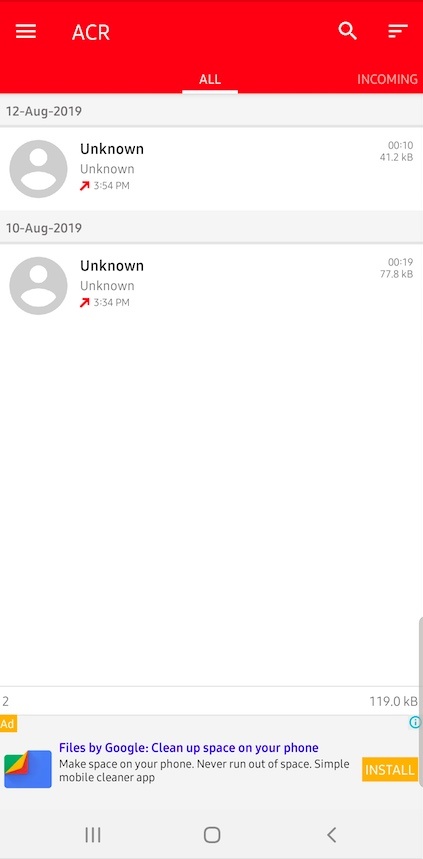
Once you have set up the app, the calls (incoming or outgoing) will automatically be recorded. You can further listen, edit, share, edit numbers, or perform more tasks with the available call recordings. You can even transcribe the calls, add notes, or back up the recordings on the supported Cloud storage services.
Pros: Ease of usage
Cons: Comes with ads
Google Play Store Rating: 3.7
Downloads: More than ten million
4. Automatic Call Recorder
The Automatic Call Recorder app’s simplicity is enough to be part of our Android call recording app list. All you have to do is follow the usual method of giving the app audio and call access, and you will be able to record phone conversations. Calls will be added to the app in different sections, namely incoming calls, outgoing calls, all calls, or important calls.
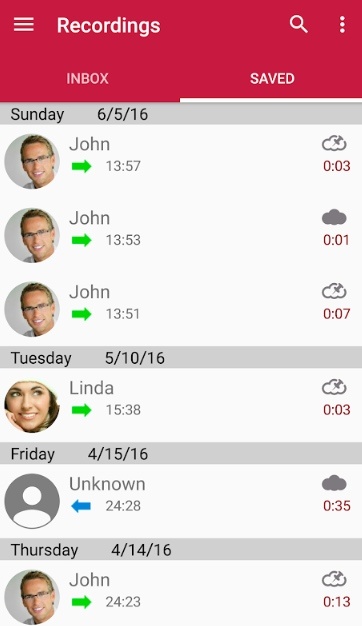
Furthermore, you can delete or share the call recordings and add a couple of settings, such as excluding a couple of numbers from the call recorder app, setting up a pin for the app, and choosing the app icon to show while recording, and more.
Pros: Added settings options
Cons: Too many ads, especially in the beginning
Google Play Store Rating: 3.8
Downloads: More than one hundred million
5. Call Recorder Automatic
Much like other call recording apps, the recorder asks for permission to access storage, record calls, manage calls, and contacts on a smartphone. It also ensures that call recordings are legal in your region for security purposes.
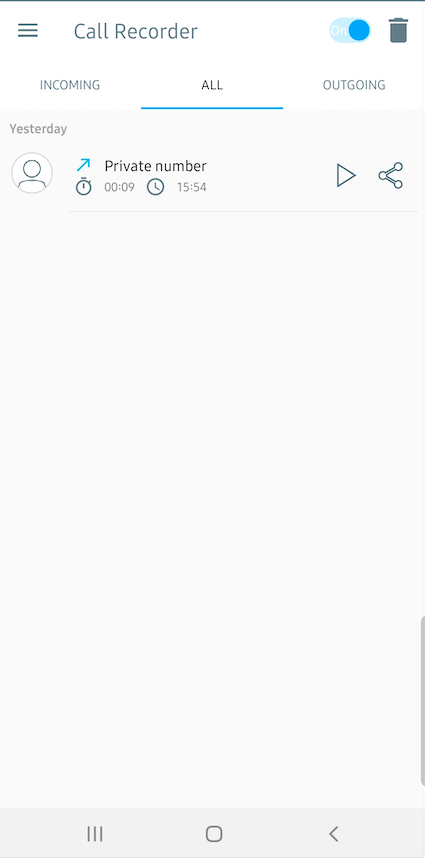
The app has a simple interface wherein there are three sections: Incoming calls, All calls, and Outgoing calls. You will get a couple more settings, such as the option to upgrade to Premium and back up to the cloud, apart from deleting the call recordings.
As a reminder, the calls can only be recorded when the speaker of the device is switched on.
Pros: Backup to cloud storage
Cons: Need for a speaker for call recording
Google Play Store Rating: 4.0
Downloads: More than ten million
6. All Call Recorder Lite 2020
The All Call Recorder Lite 2020 is a call recorder Android app that is lightweight and has a simple UI. The app is divided into four sections: all calls, outgoing calls, incoming calls, and urgent calls.
The call recorder app comes with various settings options such as the ability to exclude numbers from which you don’t wish to record calls, unlock the app with the use of a PIN, sharing options, and even the option to remove ads (which didn’t work while I was using it).
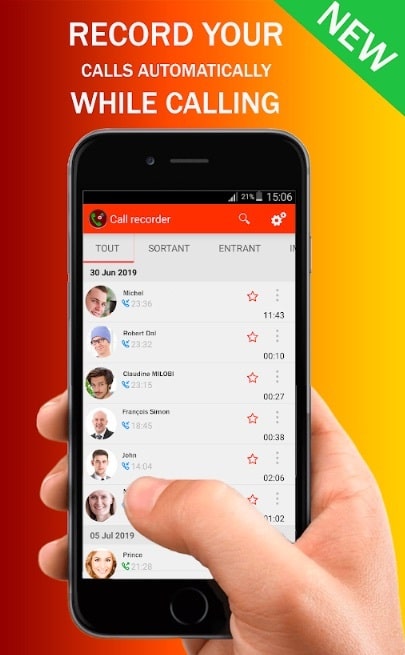
The app is easy to use and doesn’t require a lot of setups to make the call recording process work. However, it does contain adverts.
Pros: PIN setup
Cons: Ads
Google Play Store Rating: 4.2
Downloads: More than five million
7. BlackBox Call Recorder
When the Call Recorder app is launched, you will get a bunch of warnings you should know: the app has one-sided recording on some carriers, non-compatibility with other voice recording apps, power-saving mode, and a couple of permissions it takes before commencing the process.
The app, once opened, displays all the call recordings and has a hamburger menu on the left side wherein lies various other options and a search logo at the right to look for specific call recordings quickly.

There are several settings under the Settings option and a Remove ads option, which requires you to pay for it. Furthermore, the call recordings can be sorted as per duration, date, name, and more, making things convenient.
Pros: Ease of usage
Cons: One-sided recording
Google Play Store Rating: 4.2
Downloads: More than five million
8. Auto Call Recorder
The Auto Recorder app, the seventh entry on our best call recording app list, first asks for necessary permissions and is then ready to use it. Much like the various phone recording apps, the Auto Recorder has a page that lists all the calls recorded, with a menu on the left that has options such as All calls, Outgoing calls, Incoming calls, and Favorite calls, Settings, and more.

The right side has the search icon for the ability to search call recordings you need, and then there are ads being displayed at the bottom part of the app; sometimes, they pop up as well. The usage is pretty straightforward. However, I would have wished for less or no ads at all. For a no-ad experience, you can upgrade to Call Recorder Pro by just shelling out some money.
Pros: App Lock option
Cons: Loads of ads
Google Play Store Rating: 4.1
Downloads: More than five million
If you are someone who wants to keep hold of calls made or received, we hope the list mentioned above helps you in some way.
As a quick reminder, the Google Play Store has a plethora of call recorder app options. We chose the ones mentioned above based on ratings, personal experience, and user reviews. You can, by all means, go for the ones you like even if they aren’t on our call recording app list and drop your feedback.
The post 7 Best Call Recorder Apps For Android (2020) You Should Use appeared first on Fossbytes.
Technology
Software that monitors students during tests perpetuates inequality and violates their privacy
The coronavirus pandemic has been a boon for the test proctoring industry. About half a dozen companies in the US claim their software can accurately detect and prevent cheating in online tests. Examity, HonorLock, Proctorio, ProctorU, Respondus and others have rapidly grown since colleges and universities switched to remote classes.
While there’s no official tally, it’s reasonable to say that millions of algorithmically proctored tests are happening every month around the world. Proctorio told the New York Times in May that business had increased by 900% during the first few months of the pandemic, to the point where the company proctored 2.5 million tests worldwide in April alone.
I’m a university librarian and I’ve seen the impacts of these systems up close. My own employer, the University of Colorado Denver, has a contract with Proctorio.
It’s become clear to me that algorithmic proctoring is a modern surveillance technology that reinforces white supremacy, sexism, ableism, and transphobia. The use of these tools is an invasion of students’ privacy and, often, a civil rights violation.
If you’re a student taking an algorithmically proctored test, here’s how it works: When you begin, the software starts recording your computer’s camera, audio, and the websites you visit. It measures your body and watches you for the duration of the exam, tracking your movements to identify what it considers cheating behaviors. If you do anything that the software deems suspicious, it will alert your professor to view the recording and provide them a color-coded probability of your academic misconduct.
Depending on which company made the software, it will use some combination of machine learning, AI, and biometrics (including facial recognition, facial detection, or eye tracking) to do all of this. The problem is that facial recognition and detection have proven to be racist, sexist, and transphobic over, and over, and over again.
In general, technology has a pattern of reinforcing structural oppression like racism and sexism. Now these same biases are showing up in test proctoring software that disproportionately hurts marginalized students.
A Black woman at my university once told me that whenever she used Proctorio’s test proctoring software, it always prompted her to shine more light on her face. The software couldn’t validate her identity and she was denied access to tests so often that she had to go to her professor to make other arrangements. Her white peers never had this problem.
Similar kinds of discrimination can happen if a student is trans or non-binary. But if you’re a white cis man (like most of the developers who make facial recognition software), you’ll probably be fine.
Students with children are also penalized by these systems. If you’ve ever tried to answer emails while caring for kids, you know how impossible it can be to get even a few uninterrupted minutes in front of the computer. But several proctoring programs will flag noises in the room or anyone who leaves the camera’s view as nefarious. That means students with medical conditions who must use the bathroom or administer medication frequently would be considered similarly suspect.
Beyond all the ways that proctoring software can discriminate against students, algorithmic proctoring is also a significant invasion of privacy. These products film students in their homes and often require them to complete “room scans,” which involve using their camera to show their surroundings. In many cases, professors can access the recordings of their students at any time, and even download these recordings to their personal machines. They can also see each student’s location based on their IP address.
Privacy is paramount to librarians like me because patrons trust us with their data. After 9/11, when the Patriot Act authorized the US Department of Homeland Security to access library patron records in their search for terrorists, many librarians started using software that deleted a patron’s record once a book was returned. Products that violate people’s privacy and discriminate against them go against my professional ethos, and it’s deeply concerning to see such products eagerly adopted by institutions of higher education.
This zealousness would be slightly more understandable if there was any evidence that these programs actually did what they claim. To my knowledge, there isn’t a single peer-reviewed or controlled study that shows proctoring software effectively detects or prevents cheating. Given that universities pride themselves on making evidence-based decisions, this is a glaring oversight.
Fortunately, there are movements underway to ban proctoring software and ban face recognition technologies on campuses, as well as congressional bills to ban the US federal government from using face recognition. But even if face recognition technology were banned, proctoring software could still exist as a program that tracks the movements of students’ eyes and bodies. While that might be less racist, it would still discriminate against people with disabilities, breastfeeding parents, and people who are neuroatypical. These products can’t be reformed; they should be abandoned.
Cheating is not the threat to society that test proctoring companies would have you believe. It doesn’t dilute the value of degrees or degrade institutional reputations, and student’s aren’t trying to cheat their way into being your surgeon. Technology didn’t invent the conditions for cheating and it won’t be what stops it. The best thing we in higher education can do is to start with the radical idea of trusting students. Let’s choose compassion over surveillance.
Shea Swauger is an academic librarian and researcher at the University of Colorado Denver.
Technology
5 Reasons Why You Should Buy The New Maruti Suzuki S-Cross 2020
Ever since Maruti Suzuki discontinued diesel engines, its SUV S-Cross went off the sales chart as it only had a diesel variant. However, the 2020 Maruti Suzuki S-Cross is back with a powerful new hybrid petrol engine and better looks.
As reported in our previous article, the bookings for SUV are already open and you can book it from the nearest Nexa outlet or through online platforms. However, at that time we knew very little about the specifications of the new S-Cross. As the automaker confirms the details of the SUV, we can say the new S-Cross is quite impressive.
In fact, this SUV is worth considering before buying a new car in the compact SUV segment. Here are the reasons why we think you should check out the all-new 2020 Maruti Suzuki S-Cross.
5 Reasons Why Maruti Suzuki S-Cross
1. Improved Built Quality And Safety Standards
Unlike the reputation of the automaker for built quality, Maruti Suzuki S-Cross is quite impressive with its high-end safety standards. The SUV has a five-star safety rating in ASEAN NCAP crash test.
With an overall score of 15.48 out of 16 for adult occupant protection, S-Cross is one of the safest cars in its segment.
Poor safety standards are one of the major reasons why people switch away from Maruti cars. With this assurance, you can go for S-Cross without any hesitation.
2. Hybrid Powertrain

The new Maruti Suzuki S-Cross is one of the most affordable SUVs with a hybrid powertrain. The latest variant of this compact SUV is equipped with Suzuki’s Smart Hybrid Vehicle Technology (SHVS).
Under the hood is a combination of a K15B 1.5-liter BS6 compliant petrol engine and an electric motor. The electric motor gets power from two small lithium-ion battery packs.
With this powertrain, the SUV gets a total output of 103 BHP and 138 Nm of peak torque. The engine is available with both manual and automatic transmission.
Not only does the S-Cross have decent power delivery, but it also has very low carbon emissions due to the hybrid powertrain. Maruti Suzuki S-Cross is a very good option for masses who prefer eco-friendly cars.
Apart from this, Maruti Suzuki has provided features like Idle Start-Stop (ISS), Brake Energy Regeneration, and Torque assist during acceleration for a better experience.
3. Impressive Mileage
Being an SUV, S-Cross has quite an impressive fuel- efficiency. The automaker claims to provide a mileage of 18.55 km/l on MT and 18.43 km/l with AT. Generally, the SUVs in this segment offer a fuel-economy of under 15 km/l. However, with a mild-hybrid and idle Start-Stop (ISS) system, Maruti Suzuki S-Cross is providing impressive mileage.
The idle start-stop system turns off the engine when the vehicle is stationary, especially when waiting at red lights, and starts it again when the clutch is pressed. This way, it cuts off unnecessary fuel-consumption.
Looking at the fuel-efficiency we can say now you don’t have to worry about fuel-economy.
4. Improved Braking And Ride Quality
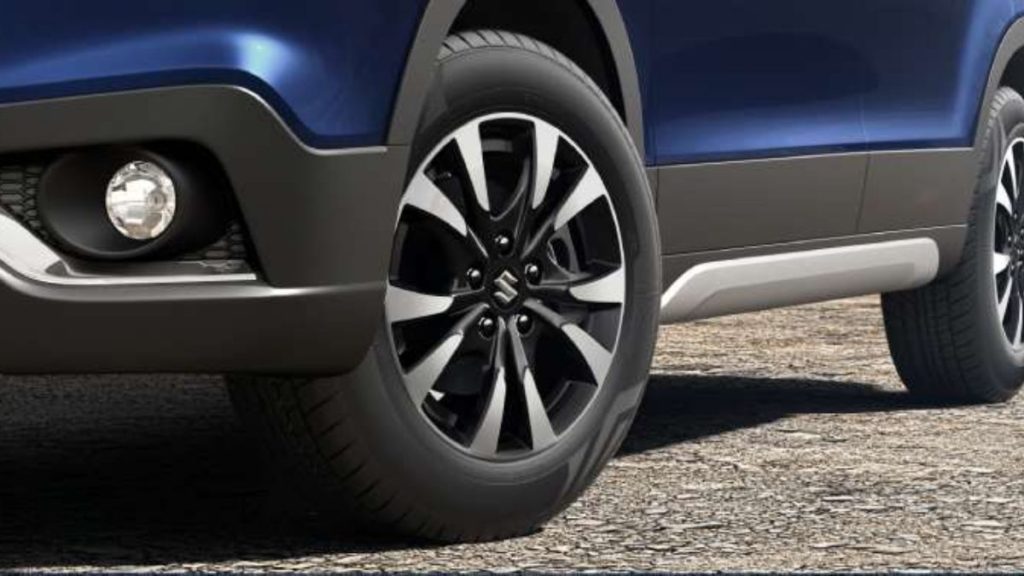
The new S-Cross comes with 4 disc brakes, which provides amazing stopping power, you can easily go into a corner with a higher speed without any worry. Well, it doesn’t mean you should over-speed, always ride within the safe speed limit.
The front disc brakes of S-Cross are ventilated for better heat dissipation. The braking force acts more on the front wheels, therefore the front wheels need to be better in all aspects than the rear one.
5. More Features, More Comfort
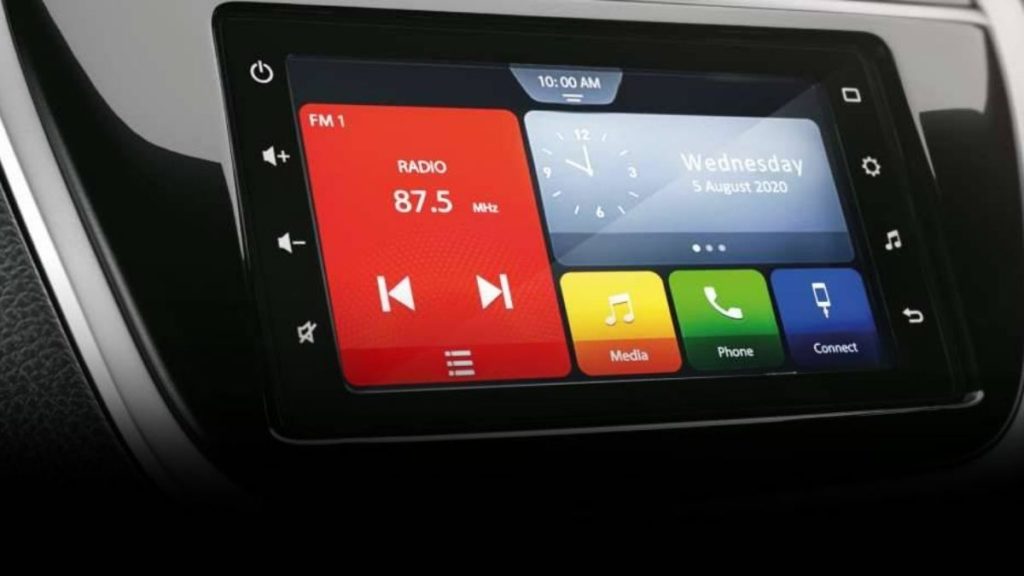
The 2020 Maruti Suzuki S-Cross features a smart infotainment system with Android Auto and Apple CarPlay connectivity. Additionally, this compact SUV is equipped with features like cruise control, autosensing rain wipers, push start, and much more.
Other than this, the rear seats of the car are made foldable that allows the user to have more cabin space. Foldable seats are very useful in putting extra luggage.
The best part is that, with all these features and a hybrid tag, the price of S-Cross starts at Rs 8.39 lakh (ex-showroom). On the other hand, there are no hybrid SUVs in this segment except the MG Hector hybrid which is almost twice in price than S-Cross. This also makes S-Cross a value for money car.
Finally, we would like to say that though it might not be the best selling car of Maruti, it’s much better than the other best selling cars of the company.
Do share your views in the comments section below.
The post 5 Reasons Why You Should Buy The New Maruti Suzuki S-Cross 2020 appeared first on Fossbytes.
Technology
This might be the most exciting Pixel rumor of the year
- A new leak suggests the Pixel 6 might fix one of the worst things about the Pixel 5, as Google has reportedly inked a deal with Samsung for custom mobile chips.
- Samsung will design and manufacture the custom chips for Google, including an “unprecedented application processor” that could help Google strengthen its hardware business.
- It’s unclear when the custom chips will be ready, but current Pixel 5 reports indicate that Google might be prepared to move away from Qualcomm soon.
Coronavirus or not, Google is having a terrible year, and things aren’t going to improve anytime soon. Buyers haven’t exactly flocked to buy the Pixel 4 phones, which are now discontinued, less than a year after their official launch. The Pixel 3a series had a similar fate, and the handset reached the end of life well before the Pixel 4a arrived. The new budget phone saw a three-month delay, and it’s facing incredible competition from the iPhone SE and the OnePlus Nord. The Nord will be the best Android alternative to the Pixel 5, although they might not go head to head in too many markets. The Pixel 5 itself might come with 5G support, a 120Hz screen, Google’s pure version of Android, and an excellent camera. But it’s a mid-range phone at best that’s going to cost as much as the cheapest iPhone 12 phones. With all that in mind, it looks as if Google has given up on Pixel hardware, which isn’t terrific news for Android itself.
I’ve often explained that Android, as it is today, isn’t working for Google anymore, that’s why the company is working on a replacement operating system that’s supposed to fix everything that’s wrong with Android. Rejuvenating the Pixel hardware might be part of that long-term plan, and that could explain the terribly annoying Pixel year that fans are experiencing. But regardless of when Google will “kill” Android, we already have a Pixel rumor that’s more exciting than any other Pixel rumor this year. And it’s not the one that says a foldable Pixel phone is coming next year.
With all the action this week, including the Pixel 4a launch and all the new Samsung hardware, a rumor from Korea was easy to miss. ETNews said that Samsung has obtained ordered from Cisco and Google for their “next-generation semiconductor chips.”
The Cisco detail is unimportant for the story, but this tidbit is:
Samsung Electronics also obtained an order from Google regarding manufacturing of more than one chip. It is heard that Google requested a semiconductor that will go into a sensor that can measure body movements rather than for processors that go into current IT devices and an unprecedented application processor (AP).
Samsung is making more than one chip for Google, not just a custom processor that will likely equip the Pixel 6 phones and possibly other 2021 Pixel versions. While the Cisco and Google orders are not confirmed, the report says they could make a meaningful impact on Samsung’s bottom line. “Google is looking to strengthen its hardware (HW) business that includes smartphone, artificial intelligence (AI) speaker, and augmented reality (AR) glasses based on its internet service,” the report reads. And that’s the kind of rumor that indicates there’s hope for the Pixel line beyond 2020.
What is interesting is that Samsung is responsible for both the design and production of the new chips, which might seem to be an unusual move. Foundries create custom chips based on the design that tech companies submit, and TSMC is the best example of that. The Taiwanese giant has been making A-series chips for iPhone and iPad for years, ever since Samsung fumbled a contract for the iPhone.
Samsung certainly has the expertise to make custom processors of its own, although it hasn’t reached Apple’s success, and the criticism of the Exynos-based Galaxy S20 phons speaks volumes. Still, Samsung’s experience could help Google create chips that might rival Apple’s A-series processors. Apple’s silicon has evolved to the point that iPhones and iPads outscore Intel chips in benchmarks, and Apple has already confirmed that the first ARM-based Macs are coming next year.
A report in mid-April said that Google is making its own chips, code-named Whitechapel, and mentioned Samsung as the co-creator of the silicon. The ETNews report provides a lot more information about the project, which makes this Pixel rumor all the more exciting.

Let’s also not forget that ARM unveiled its next-generation of reference mobile chips that will be used in next year’s smartphones. Of those, the Arm Cortex-X1 design stands out and could be used on all 2021 flagships. We speculated at the time that Pixel 6 could make use of this particular premium chip, assuming that Google wants to make the mid-range Pixel 5 forgotten.
With all that in mind, I’ll also point out another report from earlier this week that went mostly unnoticed. Samsung is considering acquiring a stake in Arm of 3% to 5%. That won’t give Samsung control over Arm, but it could certainly help with the development of future mobile chips and possibly reduce licensing fees. This wouldn’t be good news just for Samsung’s Pixel chip-making deal with Google but also for future Galaxy handsets.
The ETNews doesn’t specifically mention the Pixel 6 smartphone or any other handset brands for that matter. And while there’s no guarantee the Pixel 6 will be the first Google phone to feature a custom processor, Google will have to find a way to make the Pixel phones more competitive, especially after the Pixel 5.
-
 Business3 weeks ago
Business3 weeks agoBernice King, Ava DuVernay reflect on the legacy of John Lewis
-
World News2 weeks ago
Heavy rain threatens flood-weary Japan, Korean Peninsula
-
 Technology2 weeks ago
Technology2 weeks agoEverything New On Netflix This Weekend: July 25, 2020
-
Finance3 months ago
Will Equal Weighted Index Funds Outperform Their Benchmark Indexes?
-
Marketing Strategies7 months ago
Top 20 Workers’ Compensation Law Blogs & Websites To Follow in 2020
-
 World News7 months ago
World News7 months agoThe West Blames the Wuhan Coronavirus on China’s Love of Eating Wild Animals. The Truth Is More Complex
-
Economy9 months ago
Newsletter: Jobs, Consumers and Wages
-
 Finance8 months ago
Finance8 months ago$95 Grocery Budget + Weekly Menu Plan for 8

